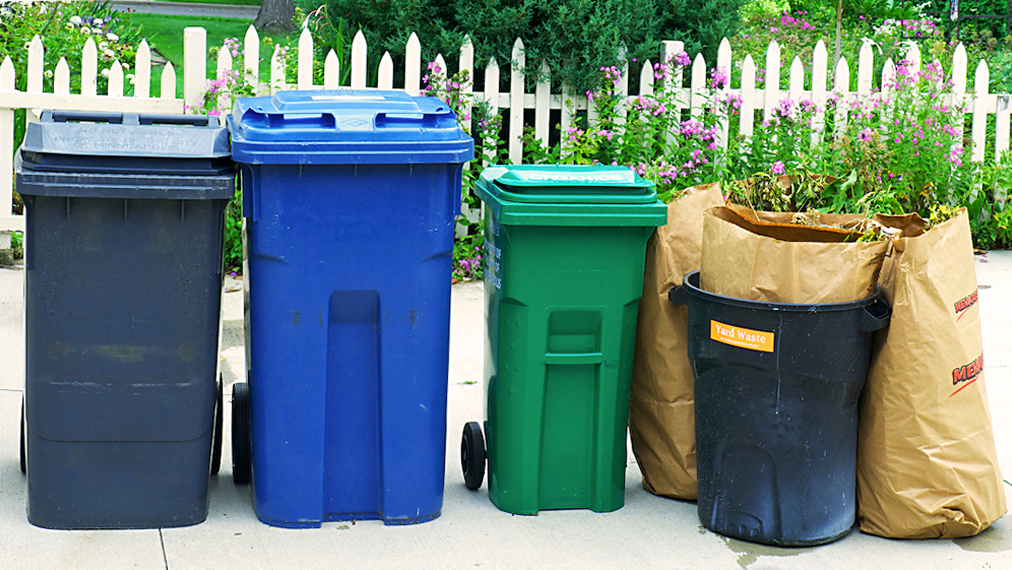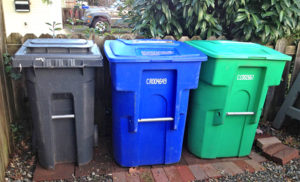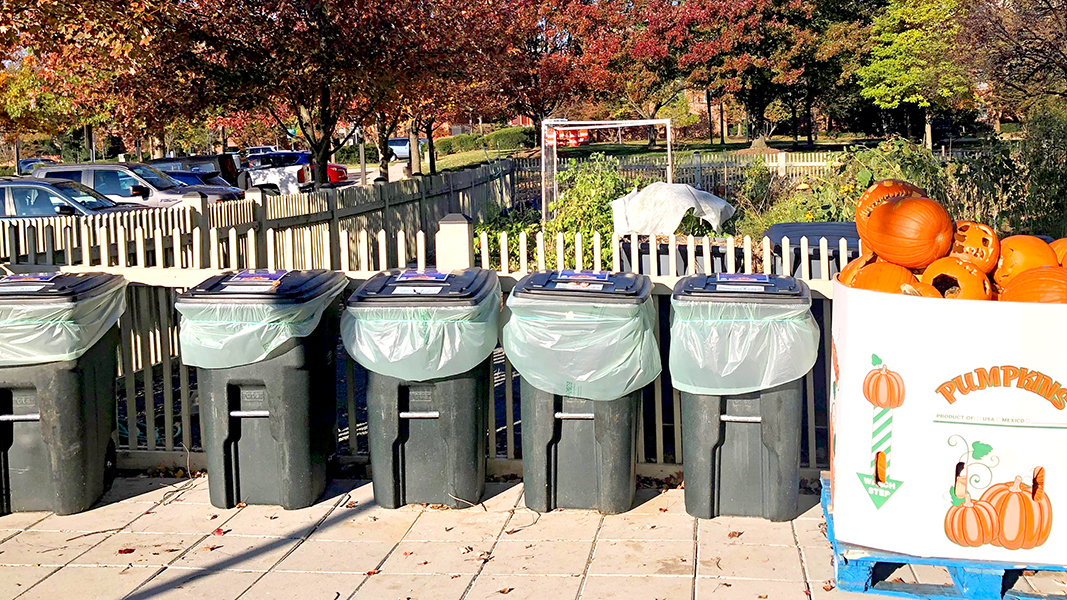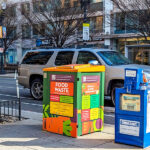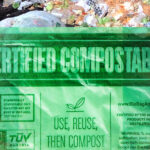Top: Residential curbside set out, including a green cart for food scraps, in Minneapolis (MN). Photo courtesy of the City of Minneapolis Division of Solid Waste & Recycling.
Nora Goldstein
The 2021 BioCycle Residential Food Scraps Collection Access Study (Access Study) reports on households in the United States that have access, via curbside collection and/or drop-off, to residential food scraps collection that is offered by their local government (municipally supported) or by a private, nonprofit or worker-owned subscription service. Over the summer and early fall, BioCycle surveyed cities, towns, counties, solid waste authorities and subscription services to learn more about their food scraps collection programs, and update data last gathered in 2017 for municipally supported programs.
The municipally supported collection programs (curbside and/or drop-off) are offered by local governments directly or by private haulers under local government contract or agreement. Municipally supported programs have been divided into three categories for the 2021 study: Curbside only; Drop-Off only; and Curbside+Drop-Off. BioCycle created the third category, Curbside+Drop-Off, to avoid double counting jurisdictions when a program offers both. The Curbside+Drop-off category captures programs that offer both municipally supported curbside and drop-off or a combination of municipally supported and private subscription services endorsed by the municipality.
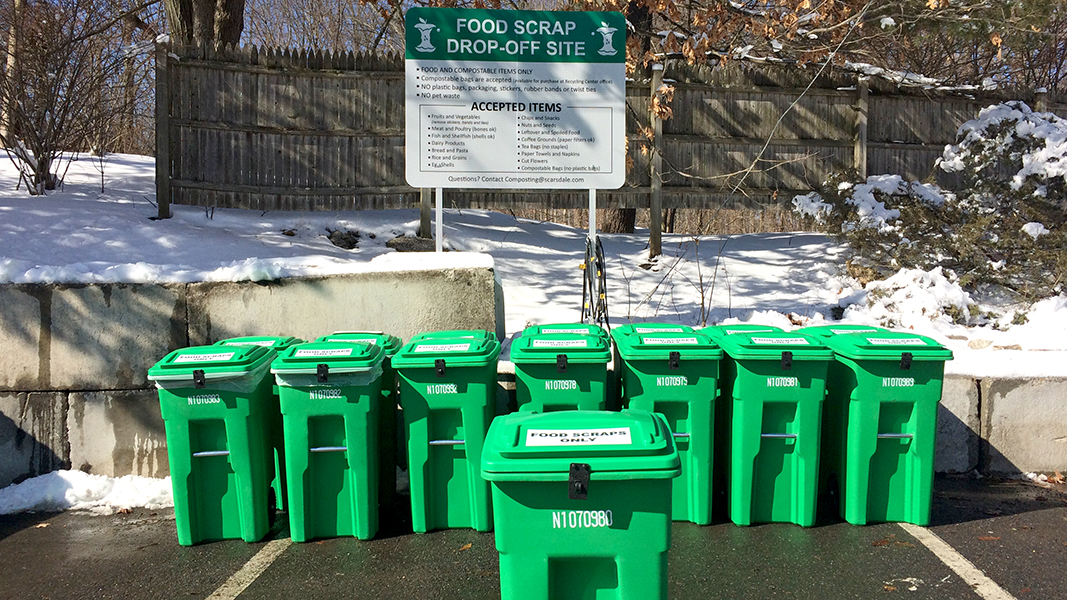
Drop-off sites, like this one in the City of Scarsdale, New York, have been established by numerous communities in Westchester County, where Scarsdale is located. Photo by Ron Schulhof
Part I of our Access Study report provides highlights of the data collected on municipally supported programs. Part II will cover private, nonprofit or worker-owned subscription services, and Part III discusses the Access Study takeaways. BioCycle will be providing a list of all the programs, by type, in Part III.
The 2021 Access Study is the first time that BioCycle has included private food scraps collection subscription services that operate separately from a municipal program. These services are being established throughout the country. Twelve states were identified — Arizona, Arkansas, Florida, Georgia, Hawaii, Indiana, Kentucky, Missouri, Montana, New Mexico, Rhode Island, and South Carolina — where the only access is provided by a private, nonprofit or worker-owned subscription service. In a number of jurisdictions that offer only drop-off, some municipal websites include links to private services that provide residential food scraps collection.
The starting “pool” of municipally supported programs was a list of 427 cities, counties or solid waste authorities. Many were included in the 2017 BioCycle Access Study and many new programs were added. For the private/nonprofit/worker-owned subscription services, the starting pool was 124. All municipally supported and subscription service programs received a survey questionnaire via email. As in years past, state organics recycling officials provided updated information on residential food scraps collection access programs. BioCycle extends a big thank you to all the jurisdictions and subscription services providing data for the study, and to the Biodegradable Products Institute and the Foodservice Packaging Institute for underwriting the 2021 BioCycle Residential Food Scraps Collection Access Study.
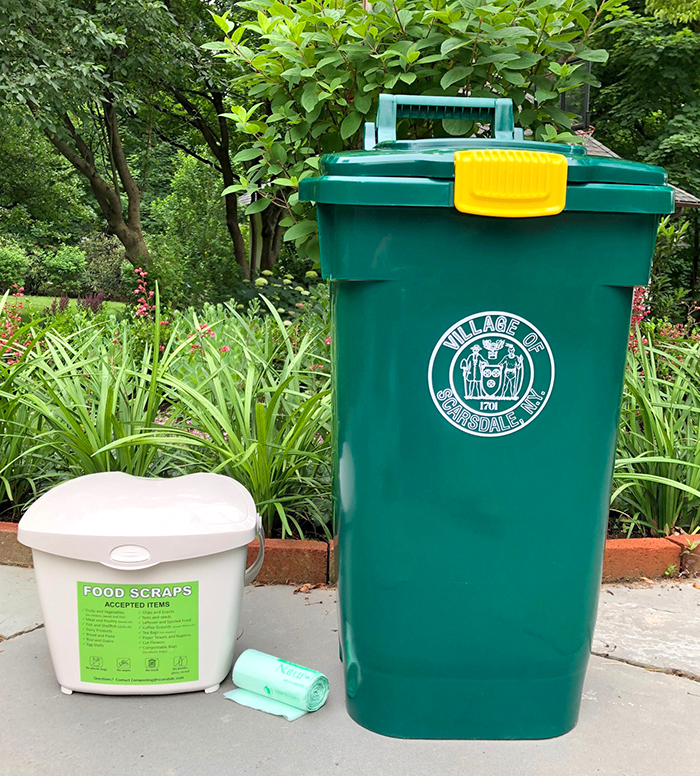
Households participating in the City of Scarsdale’s (NY) curbside collection program receive a kitchen caddy (left), a supply of certified compostable liner bags, and a dedicated cart. Photo courtesy of Ron Schulhof
How Is Access Defined?
For the purposes of this study, BioCycle uses this definition of access: “freedom or ability to obtain or make use of something” (Merriam Webster). When applied to residential food scraps collection, households that fall within a municipally supported program’s parameters have access.
An example is a municipality that establishes a curbside program to collect food scraps from all single-family homes. Each home receives a cart (standard offering), therefore all single-family households have access to residential food scraps collection. Another example is a municipality that establishes a drop-off location for household food scraps that is open to all households in the community. In this case, all households in that community — single-family and multi-family — have access.
In large cities that have municipally supported drop-off locations for residential access, every effort was made to work with a municipal contact to report as accurate a household access number as possible. New York City (NYC) is a case in point. In 2017, BioCycle included all NYC households (3.1 million) as, in theory, all had access to the City’s drop-off locations. In 2021, based on input from the NYC Department of Sanitation, a more conservative estimate (187,580 households) was used. It was calculated using data from tracking drop-off location users.
Overall Findings
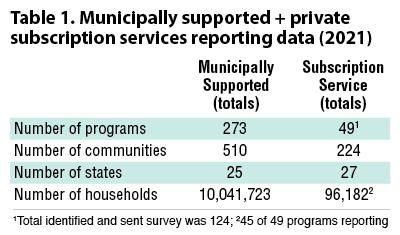 Table 1 summarizes the number of programs providing access to residential food scraps collection — both municipally supported and private subscription services. The total number of programs identified in the 2021 BioCycle study is 273. The total number of U.S. households with access to food scraps collection via municipally supported programs is 10.04 million.
Table 1 summarizes the number of programs providing access to residential food scraps collection — both municipally supported and private subscription services. The total number of programs identified in the 2021 BioCycle study is 273. The total number of U.S. households with access to food scraps collection via municipally supported programs is 10.04 million.
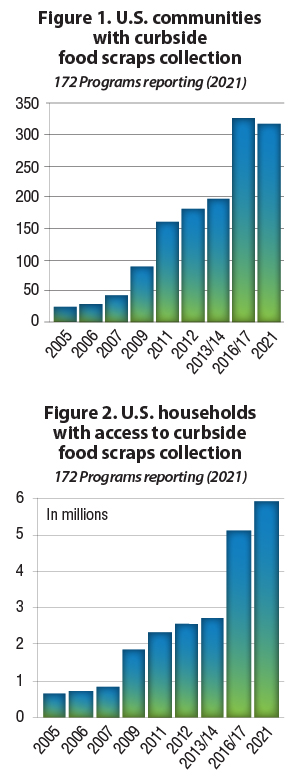 Figures 1 and 2 track curbside residential food scraps collection over time, starting with the first BioCycle National Survey in 2005. In 2005, BioCycle identified 24 U.S. communities with municipally supported curbside collection programs — compared to 318 in 2021. In 2005, 0.6 million households had access to curbside collection of food scraps; in 2021, there are 5.9 million households with curbside access.
Figures 1 and 2 track curbside residential food scraps collection over time, starting with the first BioCycle National Survey in 2005. In 2005, BioCycle identified 24 U.S. communities with municipally supported curbside collection programs — compared to 318 in 2021. In 2005, 0.6 million households had access to curbside collection of food scraps; in 2021, there are 5.9 million households with curbside access.
Table 2 compares municipally supported collection access data from the 2017 BioCycle Residential Food Scraps Collection Access Study with the 2021 study findings. The number of households being reported in 2021 is conservative, especially where BioCycle calculated access utilizing U.S. Census data on total households and the program descriptions on municipal websites. Two other important factors impacted the totals in 2021:
- Data was only included for programs that responded to the BioCycle access survey questionnaire, or those confirmed via website mining, BioCycle articles, and email inquiries. Therefore, a number of programs and communities listed in the 2017 report are not reflected in the 2021 data.
- A number of programs available in California are not captured in this study as BioCycle was unable to get in touch with program leads during the window of data collection. Outreach to these programs will continue into 2022, when more municipally supported programs are expected to be launched because of state requirements (SB 1383) ending food scraps disposal.
 As noted, municipally supported programs have been divided into three categories for the 2021 study: Curbside only; Drop-Off only; and Curbside+Drop-Off. Totals for these three categories are as follows:
As noted, municipally supported programs have been divided into three categories for the 2021 study: Curbside only; Drop-Off only; and Curbside+Drop-Off. Totals for these three categories are as follows:
- Curbside only: 133 programs, 181 communities, and 3.6 million households with access
- Drop-off only: 101 programs, 192 communities, and 4.2 million households with access
- Curbside+Drop-off: 39 programs, 137 communities, and 2.3 million households with access
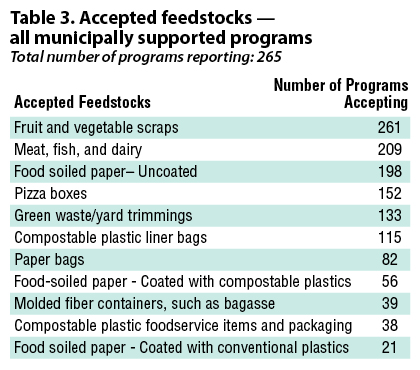 Table 3 summarizes data collected on the feedstocks accepted in municipally supported residential food scraps programs. Fruit and vegetable scraps are the number one feedstock accepted (261), followed by meat, fish and dairy (209), uncoated food-soiled paper (198), pizza boxes (152), green waste (133) and certified compostable plastic liner bags (115). Food-soiled paper coated with conventional plastics is collected by the fewest programs reporting (21).
Table 3 summarizes data collected on the feedstocks accepted in municipally supported residential food scraps programs. Fruit and vegetable scraps are the number one feedstock accepted (261), followed by meat, fish and dairy (209), uncoated food-soiled paper (198), pizza boxes (152), green waste (133) and certified compostable plastic liner bags (115). Food-soiled paper coated with conventional plastics is collected by the fewest programs reporting (21).
Program Types
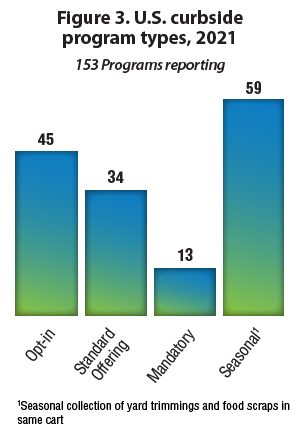 Figure 3 captures data about the types of curbside collection programs. The four categories tracked are:
Figure 3 captures data about the types of curbside collection programs. The four categories tracked are:
- Opt-In: Households must sign up for the collection service, or register to use the drop-off site(s) in order to recycle their food scraps.
- Standard Offering: Curbside collection service is offered as part of the municipal solid waste program. Households either can add food scraps to an existing yard trimmings (green waste) cart or are issued a dedicated food scraps cart. Participation is optional.
- Mandatory: Collection is offered along with trash and recycling, and participation is required. The City of San Francisco is an example of a mandatory program.
- Seasonal Collection: Typically a standard offering program where households have the option of adding food scraps to their yard trimmings cart, which is collected seasonally (typically April-November).
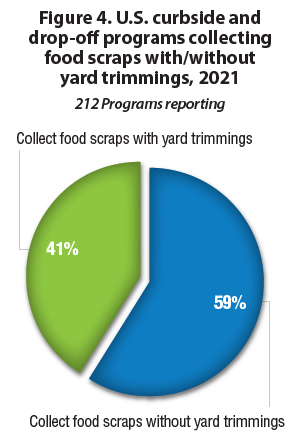 Another data point tracked by BioCycle is whether residential food scraps access programs (curbside and drop-off) use a dedicated cart for food scraps or collect food scraps with yard trimmings. As shown in Figure 4 (212 programs reporting), 41% of programs collect food scraps with yard trimmings and 59% utilize a dedicated cart.
Another data point tracked by BioCycle is whether residential food scraps access programs (curbside and drop-off) use a dedicated cart for food scraps or collect food scraps with yard trimmings. As shown in Figure 4 (212 programs reporting), 41% of programs collect food scraps with yard trimmings and 59% utilize a dedicated cart.
The Access Study survey questionnaire asked if the COVID-19 pandemic had an impact on both municipal and subscription service residential food scraps collection access programs. Of municipally supported programs responding, 44 stated that COVID-19 did not impact their program, e.g. service frequency, expansion. There was a mix of responses between some programs seeing an increase in volume from previous years (increase in lbs/household/week), while other programs saw decreased volumes and a slow down in new participation.


